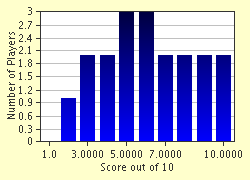Quiz Answer Key and Fun Facts
1. "Pac-Man" was designed by Tōru Iwatani and his team for the Japanese company Namco. It was released in North America in October of 1980 as "Pac-Man" but had a different name for the May release in Japan. What was it?
2. The object of "Pac-Man" was to move your character around a maze, gobbling up all the dots in the maze's pathways. You also had four ghost-like enemies trying to hunt you down. Which of these was NOT one of them?
3. To control the movement of your Pac-Man character, you had four directional arrow buttons.
4. As an aid in dealing with your ghost enemies, there were a number of 'power pellets' - larger dots - that would make your enemies vulnerable for a short time. How many power pellets were there per level?
5. When you gobbled up a power pellet, what colour did all of the ghosts turn?
6. Each dot (pellet) on a level was worth 10 points, and the power pellets were worth 50 points. After eating a power pellet, how many points did you get for each ghost you managed to eat?
7. To begin the game, you had five Pac-Man lives. After how many points did you earn a new life?
8. "Pac-Man" was significant for being the first video game to include cutscenes. In the first cutscene after level two, one of the ghosts chased Pac-Man off the screen to the left, then got chased in turn by a gigantic powered-up Pac-Man. Which ghost?
9. Another way to get points were by the bonus 'fruit' that would appear in the space where your Pac-Man began each level. They were not all fruit, but the first five items were. Which bonus item was worth the most (5,000) points?
10. It should have been possible to play "Pac-Man" indefinitely, if you could stay ahead of the ghosts, but there was a glitch in the code that caused a garbled split screen (garbled on the right half of the screen) once you reached a certain level. Which level?
Source: Author
reedy
This quiz was reviewed by FunTrivia editor
kyleisalive before going online.
Any errors found in FunTrivia content are routinely corrected through our feedback system.

